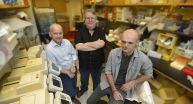Mangroves protecting corals from climate change
2014-10-08
(Press-News.org) Certain types of corals, invertebrates of the sea that have been on Earth for millions of years, appear to have found a way to survive some of their most destructive threats by attaching to and growing under mangrove roots.
Scientists with the U.S. Geological Survey and Eckerd College recently published research on a newly discovered refuge for reef-building corals in mangrove habitats of the U.S. Virgin Islands. More than 30 species of reef corals were found growing in Hurricane Hole, a mangrove habitat within the Virgin Islands Coral Reef National Monument in St. John.
Corals are animals that grow in colonies, forming reefs over time as old corals die and young corals grow upon the calcium carbonate or limestone skeletons of the old corals. Coral reefs make up some of the most biologically diverse habitats on Earth, and face many threats such as coastal pollution, dredging and disease. However, some of their most widespread threats involve warming ocean temperatures, solar radiation and increased ocean acidification.
It is from these threats that corals are finding refuge under the red mangroves of Hurricane Hole. Red mangroves, subtropical or tropical trees that colonize coastlines and brackish water habitats, have networks of prop roots that extend down toward the seafloor, and corals are growing on and under these roots.
How does it work?
Mangroves and their associated habitats and biological processes protect corals in a variety of ways.
The shade provided by mangroves protects the corals from high levels of solar radiation. This in turn, may reduce some of the stress caused by warming ocean waters.
A combination of chemical, biological and physical conditions around the mangrove habitats helps protect the corals by keeping acidity in the water below harmful levels. With oceans becoming more acidic due to the increased amount of carbon dioxide absorbed from the atmosphere, ocean animals like corals are threatened by rising acidity levels, which can slow coral growth and impact reef structure.
The shade provided by the mangroves helps deter coral bleaching, a condition that essentially starves coral and can, in prolonged cases, result in their death. With climate change, coral bleaching episodes are becoming more frequent around the world.
Bleaching occurs when corals lose their symbiotic algae. Most corals contain algae called zooxanthellae within their cells. The coral protects the algae, and provides the algae with the compounds they need for photosynthesis. The algae, in turn, produce oxygen, help the coral to remove waste products, and, most importantly, provide the coral with compounds the coral needs for everyday survival. When corals are under prolonged physiological stress, they may expel the algae, leading to the condition called bleaching.
When examining corals for this study, researchers found evidence of some species thriving under the mangroves while bleaching in unshaded areas outside of the mangroves. Boulder brain corals, for example, were found in abundance under the mangroves and were healthy, while many of those in unshaded areas a short distance away were bleaching.
Adapting to Climate Change?
Organisms throughout the world are threatened as climate and other conditions change. If they can find ways to adapt, as it appears these coral have, they can continue to survive as part of an invaluable piece of this world's intricate ecological puzzle. It is not known how many other mangrove areas in the world harbor such a high diversity of corals, as most people do not look for corals growing in these areas. No coral reefs have been identified to date that protect from rising ocean temperatures, acidification and increased solar radiation like these mangrove habitats in St. John.
INFORMATION:
ELSE PRESS RELEASES FROM THIS DATE:
2014-10-08
CHAMPAIGN, Ill. — A new study offers fresh insights into how talking on a cell phone or to a passenger while driving affects one's performance behind the wheel. The study used a driving simulator and videophone to assess how a driver's conversation partner influences safety on the road.
"We've done years of study on driver distraction, and previous studies suggest that passengers often aren't distracting. In fact, passengers can be helpful, especially if they're adults who have had experience and also are active drivers themselves," said University of Illinois psychology ...
2014-10-08
Peer-to-peer file sharing of movies, television shows, music, books and other files over the Internet has grown rapidly worldwide as an alternative approach for people to get the digital content they want -- often illicitly. But, unlike the users of Amazon, Netflix and other commercial providers, little is known about users of peer-to-peer (P2P) systems because data is lacking.
Now, armed with an unprecedented amount of data on users of BitTorrent, a popular file-sharing system, a Northwestern University research team has discovered two interesting behavior patterns: ...
2014-10-08
Cold Spring Harbor, NY – It's one of those ideas that seems to make perfect sense: the bigger the brain, the more intelligent the creature. While it is generally true, exceptions are becoming increasingly common. Yet the belief persists even among scientists. Most biologists, for example, assume that rats, with larger brains, are smarter than mice. Cold Spring Harbor Laboratory (CSHL) scientists now challenge this belief. They compared mice and rats and found very similar levels of intelligence, a result that could have powerful implications for researchers studying ...
2014-10-08
WASHINGTON - Children who are emotionally abused and neglected face similar and sometimes worse mental health problems as children who are physically or sexually abused, yet psychological abuse is rarely addressed in prevention programs or in treating victims, according to a new study published by the American Psychological Association.
"Given the prevalence of childhood psychological abuse and the severity of harm to young victims, it should be at the forefront of mental health and social service training," said study lead author Joseph Spinazzola, PhD, of The Trauma ...
2014-10-08
AUGUSTA, Ga. – A fundamental theory about how our thymus educates our immune police appears to be wrong, scientists say.
It's known that stem cells come out of the bone marrow and travel to the tiny thymus gland behind the breastbone to learn to become one of two CD4T cell types: one leads an attack, the other keeps the peace.
One widely held concept of why they become one or the other is that, despite coming from the same neighborhood and going to the same school, they are exposed to different things in the thymus, said Dr. Leszek Ignatowicz, immunologist at ...
2014-10-08
Rockville, MD – The Society for Disaster Medicine and Public Health is committed to examining the details of individual disasters and public health crises. With the recent arrival of Ebola in the United States, the journal is launching a special issue on the virus. The journal will serve as an educated and authoritative voice on the virus, risk and threat level, potential of outbreak, preparation and response for the public and media.
The Journal of Disaster Medicine and Public Health Preparedness, began covering events in their entirety via special issues this ...
2014-10-08
NEW YORK, NY (October 8, 2014)—For benign gynecologic conditions, robot-assisted surgery involves more complications during surgery and may be significantly more expensive than conventional laparoscopic surgery, according to a study by researchers at Columbia University Medical Center (CUMC). The results were published online today in Obstetrics & Gynecology.
Robot-assisted surgery was first widely used for radical prostatectomy. For procedures such as prostatectomy, where there were previously no minimally invasive options, robot-assisted laparoscopy often offered ...
2014-10-08
This news release is available in French. Montreal & Vancouver, October 8, 2014 — From the words for colours to how to tie a shoelace, kids have lots to learn — and for the most part, they depend on others to teach it to them.
But whether deliberately or inadvertently, other people sometimes misinform. So at what age can kids tell trustworthy teachers from confident tricksters?
A new study published in PLOS ONE by psychology researchers from Concordia University and the University of British Columbia shows that by the age of five, children become wary ...
2014-10-08
HOUSTON – (Oct. 8, 2014) – Managers can promote creativity in employees by "empowering leadership" and earning employees' trust, according to a new study by Rice University and American University.
The researchers investigated, for the first time, the complex effect of the interaction among empowering leadership, uncertainty avoidance and trust on creativity. They collected supervisors' ratings of employee creativity in two separate studies in China: one with employees of an energy-saving light bulb design and manufacturing company and the other with the employees ...
2014-10-08
Gay and bisexual youth who are supported by their family and feel comfortable talking to them about their lifestyle are less likely to become involved in high-risk sexual behaviors, according to a recent Rutgers study.
Published in the Journal of Marital & Family Therapy, the Rutgers School of Social Work study, Condoms and connection: Parents, gay and lesbian youth and HIV risk, found that positive family relationships and open dialogue led to an increase in safe sex practices, including the use of condoms, while disrupted family relationships resulted in risky sexual ...
LAST 30 PRESS RELEASES:
[Press-News.org] Mangroves protecting corals from climate change




